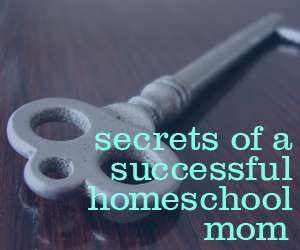
Written by Jamie Martin, editor of Simple Homeschool and founder of Steady Mom (the original post can be found on Simple Homeschool.)
Three weeks ago, I had the privilege of speaking at the Heart of the Matter virtual homeschooling conference. My topic? Secrets of a Successful Homeschool Mom.
The talk went well, and afterward I had the idea to turn it into a series for you here. So over the next few Mondays, I’ll share tips that set a homeschooling mama (or papa!) up for success in the homeschooling lifestyle.
 When I use the word “secrets,” I don’t mean they are necessarily earth-shattering ideas or principles you’ve never heard of before. In many areas of life, often the most profound truths are also the most simple.
When I use the word “secrets,” I don’t mean they are necessarily earth-shattering ideas or principles you’ve never heard of before. In many areas of life, often the most profound truths are also the most simple.I’ve called them secrets because they encompass ideas I wish I would have known at the beginning of my homeschooling journey–ideas I’ve had to figure out and stumble across along the way. If I would have known these from the beginning, I think it would have helped me approach homeschooling in a more relaxed, pressure-free way.
And with the way we often feel about the responsibility of homeschooling, I’ll sign up for a little less pressure any chance I can get right?
Which brings me to the first truth a successful homeschooling mom understands:
She realizes that homeschool doesn’t have to mean doing school at home.
Most new homeschoolers mistakenly believe that they must replicate a traditional school classroom and methodology with their children. Of course we often don’t feel equipped to do this, so it can lead to a lot of fear.
I was the same way years ago–I initially imagined having rows of desks, a flag, and having to teach six hours a day.
But what experienced homeschoolers come to realize is that homeschooling is alifestyle, not a regimen. Learning doesn’t have to be confined to specific hours–it doesn’t have to fit within artificial boundaries.
In order to see it this way, we must step off the conveyor belt of education. For most of us this doesn’t come naturally, because that is how we were educated ourselves. The conveyor belt means that children are grouped with peers according to age, they proceed along learning what officials have determined need to be learned on a certain timetable, and after thirteen years they come off the factory line with a diploma—an official stamp deeming them educated.
The conveyor belt serves some purposes in society, but there’s absolutely no need to set one up in our homes. Yet that is exactly what most homeschoolers do.
Have you heard of Sir Ken Robinson? He’s a modern-day educational reformer, and he’s had a lot to say lately about the conveyor belt model. Consider this quote from his bestselling book The Element:
“The fact is that given the challenges we face, education doesn’t need to be reformed — it needs to be transformed.The key to this transformation is not to standardize education, but to personalize it, to build achievement on discovering the individual talents of each child, to put students in an environment where they want to learn and where they can naturally discover their true passions.”
Creating an individualized education is easy for us as homeschoolers—we have the perfect opportunity, providing we can summon the courage to step off the conveyor belt.
The starting point for successfully doing so is recognizing that homeschool doesn’t have to mean school at home.
Do you feel like you’ve been able to blur the line between “school” and “home?”

No comments:
Post a Comment